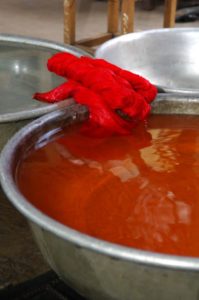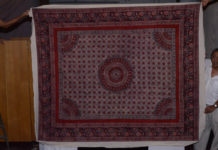Colours have some significance in Cambodia, as demonstrated by the Cambodian royal protocol, which specifies that each day of the week corresponds to a colour. During royal ceremonies, people from the Royal family and their guests are required to wear traditional outfits, such as sampots, that feature the “colour of the day”.
- Sunday: Red
- Monday: Orange
- Tuesday: Purple
- Wednesday: Mustard Green
- Thursday: Green
- Friday: Blue
- Saturday: Burgundy
 In Cambodia, the process of traditional dyeing is usually done by hand using either chemical or natural pigments. The option that is mostly used locally is the one involving chemical dyes as it is less time-consuming and results in steadier colour hues. The process simply consists in putting the right amount of colourant into hot water, and to immerse the threads in this solution until the colour appears. The threads are then dried under the sunlight, before being spun into bobbins.
In Cambodia, the process of traditional dyeing is usually done by hand using either chemical or natural pigments. The option that is mostly used locally is the one involving chemical dyes as it is less time-consuming and results in steadier colour hues. The process simply consists in putting the right amount of colourant into hot water, and to immerse the threads in this solution until the colour appears. The threads are then dried under the sunlight, before being spun into bobbins.
Using natural pigments, such as fruits, plants, resins, tree trunks and leaves, requires more time as each tinted solution has to be prepared in advance. Furthermore, as there are two distinct seasons in Cambodia – rainy and dry seasons – the use of plants often result in varying colours depending on the time of the year.
Here are a few examples of dyes that can be obtained thanks to the combination of boiling water and common plants of Cambodia:
- Bixa Orellana or achiote, also called Chumpu Choloak in Khmer, results in orange.
- Indigofera Tinctoria or true indigo, also called Trom in Khmer, results in dark blue-indigo.
- Musaceae or banana tree, also called Chék in Khmer, results in pale yellow.
- Garcinia Vilersiana, also called Prohout in Khmer, results in dark yellow.
- Azadirachta Indica Integrifolia or neem tree, also called Sdau in Khmer, results in a yellow to brown hue.
 To prepare a natural dye solution, a particular plant is either chopped in small parts or ground. The plant bits or powder obtained are then poured into a cooking pot containing boiling water and are left inside until the colour appears. At that point, the plant barks are removed and the threads are then soaked in the boiling dye solution in which an alum stone is added. After about half an hour, the threads are rinsed several times—an acid solution is added during the last rinse water. Finally, threads are dried under the sun.
To prepare a natural dye solution, a particular plant is either chopped in small parts or ground. The plant bits or powder obtained are then poured into a cooking pot containing boiling water and are left inside until the colour appears. At that point, the plant barks are removed and the threads are then soaked in the boiling dye solution in which an alum stone is added. After about half an hour, the threads are rinsed several times—an acid solution is added during the last rinse water. Finally, threads are dried under the sun.
The natural dyeing process can be observed at the Angkor Silk Farm, in the Siem Reap province. However, it is worthy to note that due to the uneven results given by natural dyes, this method is rarely used nowadays in Cambodia.





